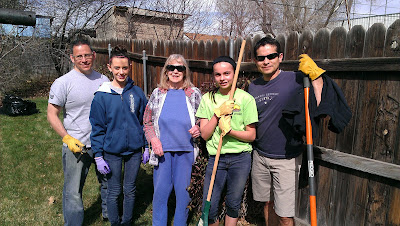If you're ever in the area, stop by our office and say "Hi". We're at 4200 Morrison Road, Unit 3, Denver, 80219.
Tuesday, April 30, 2013
Monday, April 29, 2013
Stats from 5 Years of ECM
ECM's 5 year stats:
- Neighborhoods Targeted - 8
- Blocks Adopted - 451
- Alleys Cleaned - 1,000+
- Projects Completed - 1,293
- Volunteers Participated - 14,350
- Volunteer Hours Invested in Denver Neighborhoods - 70,642.5
Wednesday, April 17, 2013
Neighborhood Spotlight: Villa Park
According to the Piton Foundation, Villa Park is about 80% Latino, 15% white, and 5% other ethnicities. The neighborhood also has a large immigrant community with more than 35% of residents born in another country. The population is mostly lower middle class with an average income of about $40,500, more than $15,000 a year less than the city of Denver's average yearly income. Around 24% of Villa Park's population is below the poverty line. Crime rates are close to Denver averages except for somewhat higher rates of burglary.
History
In 1871, developers
bought more than 1,000 acres of land in the area that now includes the Villa
Park and Barnum neighborhoods. Original plans called for a subdivision with
artificial lakes, ravines and beautiful landscape design by Frederick Law
Olmstead, the man who designed Central Park in New York City. The plan never
came to fruition and the land was sold to Judge Hiram Bond who operated a cattle
brokerage there until 1891. At that time it was sold by Bond to Helen Barnum
Hurd Buchtel, the daughter of circus owner Phineas Barnum, whose family was
active in Denver real estate. Because of unfavorable geography, Villa Park was
slow to develop and only had about 66 buildings in the area by the 1900 census.
Single-unit construction continued slowly into the 1950s when most of the
neighborhood had been fully developed. In the 1960s and 70s, more multi-unit
building construction occurred in Villa Park, primarily in the western side of
the neighborhood.
Today
The Villa Park
neighborhood consists chiefly of single-family homes with some apartment
buildings and several apartment complexes. Commercial development exists
primarily on the major thoroughfares of Sheridan and Federal Boulevards with
smaller commercial areas along 6th and 10th Avenues and Knox Court. In early
2013, the west corridor of the FasTracks is expected to be completed next to
Lakewood Gulch. The west corridor project will provide light rail service to the
neighborhood with stops at Knox Court, Perry Street and Sheridan
Boulevard.
Source: Wikipedia
More
Info: The Piton
Foundation - Villa Park
Thursday, April 11, 2013
Neighborhood Spotlight: Globeville
The changing patterns of
Globeville are inextricably bound up with the history of the community and its
ethnic and religious groups. Globeville was established on ranch land purchased
for that purpose by the Globe Smelter Company. Slavic workers were known to have
settled in the area around 1885. As other smelter and packinghouses located
nearby, local workers were attracted to Globeville. The tall smokestack
represented in Denver's City Seal depicts the smelting industry era centered in
Globeville.
History
The Globeville
neighborhood was originally settled in the late 1880s around the Globe Smelting
and Refining Company. Many of the early workers were Eastern European
immigrants, including Austrians, Croatians, Germans, Poles, Russians,
Scandinavians, Slovenians, and other Slavic peoples. In addition to the
smelters, the railroad and packing plant industries offered employment
opportunities. Even in its early years, Globeville was isolated from the rest of
the city. The railroads and South Platte River served as physical barriers. With
such limited access, the majority of people who worked within Globeville also
lived in the neighborhood. The diverse immigrant populations thrived as churches
and social organizations grew up around the various nationalities. Globeville’s
isolation was further impacted in the mid-20th century when two interstates were
constructed that bisected the neighborhood. Construction of Interstate 25 began
in 1948 and was completed in 1958. Interstate 70 was subsequently completed in
1964. Interstate 70 divided the eastern residential area of Globeville, and its
construction resulted in the loss of 30 homes.
Today
Globeville’s history as a home for immigrants has
continued into the present. Over the past few decades, an increasing Latino or
Hispanic population has moved into the Globeville neighborhood. The current mix
of multi-generational residents and new immigrants continues the rich diversity
that the Globeville neighborhood experienced in the past. Today, portions of
Globeville continue to be physically isolated from the rest of Denver by the
freeways, railroad lines, and the South Platte River. However, the freeways and
railroads have also continued to make Globeville an attractive location for
business and industry. Several large operations and employers are located within
the neighborhood and nearby, including the Denver Coliseum and Stock Show
complex, the Bannock Street furniture business district, and the Pepsi bottling
plant.
Source: Wikipedia
Sunday, April 7, 2013
4.6.13 - ECM Work Day in Barnum
Boulder County K-Life
Chaparral High School Lacrosse Team
Individuals
Summary of 4.6.13 ECM Work Day in Barnum:
- Volunteers - 95
- Projects - 14
- Volunteer Hours - 425
Wednesday, April 3, 2013
April Extreme Endeavors: Be A Good Neighbor
| |||||||||||||||
| |||||||||||||||
| |||||||||||||||
|
Subscribe to:
Comments (Atom)







